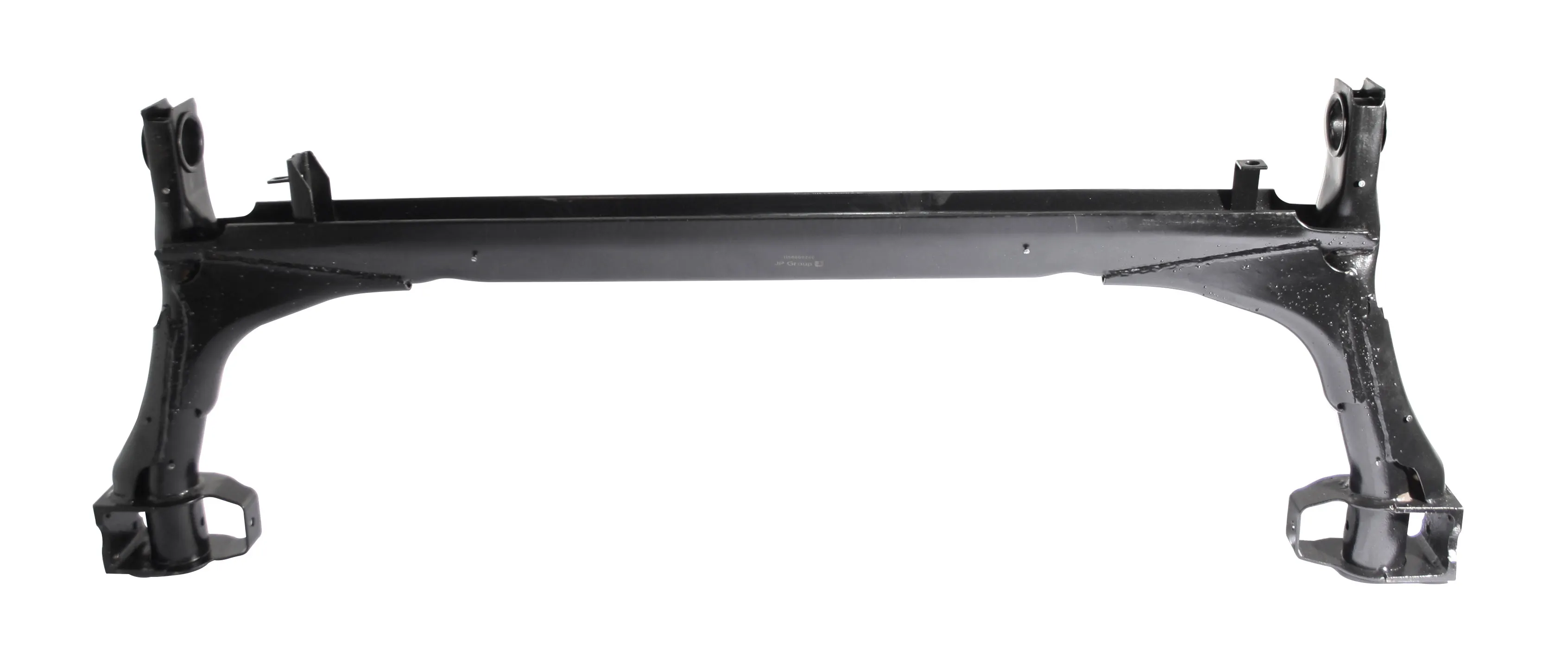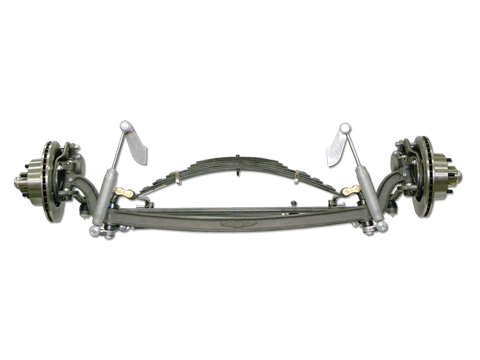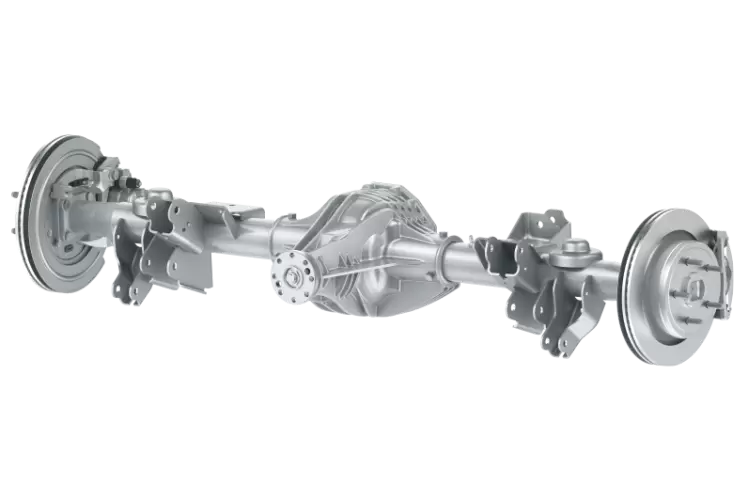
Are there potential challenges or limitations to using beam axles in vehicles?
Using beam axles in vehicles has both advantages and disadvantages. It’s important to consider the challenges and limitations associated with beam axles:
1. Ride Quality:
Beam axles are generally stiffer than independent suspension systems. This stiffness can lead to a less comfortable ride on smooth or well-paved roads, as they transmit more road imperfections and vibrations to the passengers. Passengers may perceive this as a limitation in terms of ride comfort.
2. Limited Articulation:
Beam axles have limited articulation. When one wheel encounters a bump or obstacle, the other wheel is affected as well. This can result in a bumpier ride compared to independent suspension systems, where each wheel can move independently to absorb shocks. Off-road vehicles may experience challenges in maintaining traction on rough terrains due to this limitation.
3. Reduced Traction in Some Scenarios:
Beam axles can experience reduced traction in certain scenarios, such as when one wheel loses contact with the ground. In off-road situations, this can limit the vehicle’s ability to traverse uneven terrain, especially when compared to independent suspension systems that allow each wheel to react independently to ground conditions.
4. Challenging Maneuverability:
Maneuverability can be a limitation in vehicles with beam axles. The stiffness and design of beam axles can make it harder to navigate tight spaces or execute sharp turns. This can be a drawback, especially in urban environments or when parking in confined areas.
5. Weight Distribution:
Proper weight distribution is crucial for vehicle stability. Beam axles, while offering even weight distribution between wheels on the same axle, may not provide the same level of precision in weight distribution as independent suspension systems. This can affect handling and stability in some situations.
6. Limited Ride Comfort on Smooth Roads:
On smooth and well-paved roads, solid beam axles may lead to reduced ride comfort due to their stiffness. Passengers may experience a more jarring ride, and the vehicle may struggle to absorb minor road imperfections.
7. Noise and Vibration:
Beam axles can transmit more noise and vibration from the road to the vehicle’s occupants. This can result in a less refined and quieter cabin environment compared to vehicles with independent suspension systems.
8. Suspension Tuning Challenges:
Designing the suspension components and tuning the shock absorbers for vehicles with beam axles can be challenging. Manufacturers must strike a balance between load-carrying capacity and ride comfort. Achieving an ideal balance can be difficult and may require compromises.
9. Vehicle-Specific Considerations:
The limitations of beam axles can vary depending on the vehicle’s intended use and design. While some limitations may be acceptable in off-road or heavy-duty applications, they may not be suitable for passenger cars or vehicles designed for urban commuting.
Summary:
Beam axles offer advantages in terms of durability and load distribution, but they also come with limitations related to ride comfort, maneuverability, and traction in certain scenarios. Vehicle manufacturers must carefully consider these limitations and weigh them against the specific needs and intended use of the vehicle.

Are there specific driving conditions or terrains where beam axles perform better?
Beam axles are well-suited for certain driving conditions and terrains where their design and characteristics provide advantages. Here are some situations where beam axles may perform better:
1. Off-Road and Rough Terrain:
Beam axles are highly effective in off-road and rough terrain environments. Their key advantages in such conditions include:
- Ground Clearance: Beam axles often provide good ground clearance, allowing vehicles to navigate over rocks, ruts, and uneven terrain without getting stuck.
- Wheel Articulation: Beam axles offer excellent wheel articulation, allowing the wheels to maintain contact with the ground even when the terrain is uneven. This enhances traction and stability.
- Durability: Off-road environments can be punishing, and beam axles are known for their durability and resistance to damage from impacts and obstacles.
2. Heavy-Duty and Commercial Vehicles:
Beam axles are commonly used in heavy-duty and commercial vehicles due to their load-bearing capacity and robustness. In such applications:
- Weight Distribution: Beam axles help distribute the weight of the vehicle and cargo evenly, which is critical for load-bearing and stability in applications like trucks and buses.
- Durability and Longevity: Commercial vehicles endure extensive use, so the durability of beam axles is advantageous for minimizing maintenance and downtime.
3. Simplified Maintenance:
Beam axles are relatively easy to maintain and repair, making them suitable for applications where accessibility to service and maintenance is essential. Simple designs can save time and resources in maintenance operations.
4. Classic and Vintage Cars:
Some classic and vintage vehicles use beam axles, and enthusiasts appreciate the authenticity and historical significance of these designs. While they may not be the most advanced suspension systems, they offer a unique driving experience.
5. Towing and Trailering:
Beam axles are often used in trailers and semi-trailers, providing support for the trailer’s weight and cargo. Their load-bearing capacity and simplicity make them suitable for these applications.
6. Custom Off-Roading and 4×4 Vehicles:
Enthusiasts and off-road hobbyists often modify their vehicles with beam axles to improve off-road performance. Lifted suspensions and enhanced articulation can make custom 4×4 vehicles better suited for challenging terrains.
Summary:
Beam axles excel in specific driving conditions and terrains, particularly in off-road, heavy-duty, and commercial applications. Their robustness, ground clearance, and durability are key attributes that make them perform better in these environments. However, in everyday passenger cars and modern vehicles, independent suspension systems are more common due to their comfort and handling advantages on paved roads.

What is a beam axle, and how does it differ from independent suspension?
A beam axle, also known as a solid axle or live axle, is a type of suspension system used in vehicles. It differs from independent suspension in several ways:
Beam Axle:
- A beam axle consists of a single solid beam (shaft) that spans the width of the vehicle and connects both wheels on the same axle. It is a single rigid unit.
- Beam axles are commonly found in older vehicles and some heavy-duty trucks and off-road vehicles.
- When one wheel encounters a bump or obstacle, the other wheel on the same axle is affected. This can result in a less comfortable ride and reduced traction for both wheels.
- Beam axles are generally more robust and suitable for heavy loads, making them preferred in certain commercial and industrial applications.
- They are relatively simple in design and tend to be more cost-effective to manufacture and maintain.
Independent Suspension:
- Independent suspension, on the other hand, allows each wheel to move independently of the other. It consists of separate suspension units for each wheel.
- Independent suspension is commonly used in modern passenger cars, SUVs, and performance vehicles.
- Each wheel responds individually to road imperfections, providing a smoother and more comfortable ride. It also improves traction, handling, and stability.
- Independent suspension is generally lighter and offers better handling characteristics, making it suitable for most everyday driving situations.
- However, it can be more complex and costly to manufacture and maintain compared to beam axles.
While beam axles are known for their strength and simplicity, independent suspension systems are favored for their superior ride comfort, handling, and adaptability to various road conditions. The choice between the two depends on the vehicle’s intended use, design goals, and the trade-off between load-carrying capacity and ride quality.


editor by CX 2023-12-27